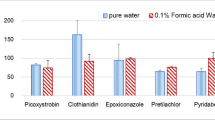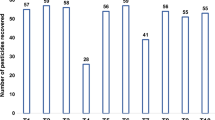Abstract
In this article matrix components in spinach were investigated in detail. The samples were prepared using two QuEChERS (quick, easy, cheap, effective, rugged and safe) methods, AOAC and CEN. Liquid chromatography–electrospray ionization–tandem mass spectrometry (LC–ESI–MS/MS), gas chromatography–mass spectrometry (GC–MS) and ultra performance liquid chromatography-diode array detector (UPLC-DAD), were applied for component identification. The strategies of identification by LC–ESI–MS/MS include accurate mass spectra of the parent ion, comparison with previous literature data and investigation of the mass spectral decomposition pattern. Overall, fourteen components were identified by LC–ESI–MS/MS in each methods of AOAC and CEN, which were phytosteroids, flavonoids, fatty acids and fatty acid amides. Fifty components using AOAC method and fifty-seven components using CEN method were identified in GC–MS by comparing mass data with the National Institute of Standards and Technology (NIST, U.S.) database. The results indicate that the major components of the matrix are terpenoids, fatty acids and fatty acid esters. Moreover, three pigments (neoxanthin, violaxanthin and lutein) in the AOAC method and eight pigments (neoxanthin, violaxanthin, zeaxanthin, lutein, chlorophyll a, chlorophyll b, pheophytin a and beta-carotene) in the CEN method that gave a characteristics peak at 440 nm were identified by the UPLC-DAD. According to the sample preparation condition using different amounts of graphitized carbon black (GCB) in this study, the AOAC method had higher matrix component removal efficiency than the CEN method. A better understanding of matrix components would increase the current knowledge for improvement of existing QuEChERS methodology, as well as contribute to new method developments.



Similar content being viewed by others
References
Anneli K, Allan K, Koit H, Ivo L (2008) Matrix effects in pesticide multi-residue analysis by liquid chromatography–mass spectrometry. J Chromatogr A 1187:58–66
Antonia GF, Jose LMV, Jose LFM, Roberto RG (2009) Compensation for matrix effects in gas chromatography–tandem mass spectrometry using a single point standard addition. J Chromatogr A 1216:4798–4808
Benjamin FC, Oscar PG, Gary S, Norton BG, Steven JH, Dale LB, Richard AL (1995) Chemical characterization of a family of brain lipids that induce sleep. Science 268:1506–1509
Daniele FF, Lara ZSB, Carla P, Eduardo JP, Diogenes AGC (2014) Phytochemical analysis of Pfaffia glomerata inflorescences by LC–ESI–MS/MS. Molecules 19:15720–15734
Erich-Christian O, Heinz-Wilhelm D (2004) Safeguarding production—losses in major crops and the role of crop protection. Crop Prot 23:275–285
Eulogio JLM, Vitor S, Sandra G, Paula CC (2015) HPLC-ESI-MSn characterization of phenolic compounds, terpenoid saponins, and other minor compounds in Bituminaria bituminosa. Ind Crops Prod 69:80–90
European committee for standardization (2008) Foods of plant origin—determination of pesticide residues using GC-MS and/or LC-MS/MS following acetonitrile extraction/partitioning and cleanup by dispersive SPE—QuEChERS-method; EN 15662
Filipa S, Ricardo CC, Lillian B et al (2017) Flavonoid composition and antitumour activity of bee bread collected in northest Portugal. Molecules. https://doi.org/10.3390/molecules22020248
Helen S, Stefan K, Gunther K, Lutz A (2012) Reduction of matrix effects in liquid chromatography–electrospray ionization–mass spectrometry by dilution of the sample extracts: how much dilution is needed. Anal Chem 84:1474–1482
Jennifer B, Paul DF, Peter MB (2003) Identification and quantification of carotenoids, tocopherols and chlorophylls in commonly consumed fruits and vegetables. Phytochemistry 62:939–947
Jinfeng W, Ziyao J, Zhihao Z et al (2017) Analysis of chemical constituents of Melastoma dodecandrum Lour. by UPLC-ESI-Q-Exactive Focus-MS/MS. Molecules 22:476. https://doi.org/10.3390/molecules22030476
Joaquim MDA, Giuseppina N, Antonio S et al (2007) Antiproliferative and antioxidant activities of a tricin acylated glycoside from sugarcane (Saccharum officinarum) juice. Phytochemistry 68:1165–1171
Jocelyne H, Joseph B, Emmanuel G, Dave MT, Paul GO (1994) Electrospray tandem mass spectroscopy of ecdysteroid moulting hormones. Spectroscopy 12:43–53
Katerina M, Philip LW (2012) Evaluation of a new column backflushing set-up in the gas chromatographic-tandem mass spectrometric analysis of pesticide residues in dietary supplements. J Chromatogr A 1265:155–164
Kuniyo S, Machiko S, Takeshi S, Sadao N, Akira T, Kazuichi H (2012a) Matrix behavior during sample preparation using metabolomics analysis approach for pesticide residue analysis by GC–MS in agricultural products. J Agric Food Chem 60:10226–10234
Kuniyo S, Sadao N, Norimichi O, Kazushi M, Munetomo N, Akira T, Kazuichi H (2012b) Search of components causing matrix effects on GC/MS for pesticide analysis in food. J Pestic Sci 37:156–163
Kuniyo S, Kazuyuki Y, Sadao N (2015) Difference in the matrix components by cleanup methods between the notified multiresidue pesticide analysis method in Japan and the QuEChERS method. J Pestic Sci 40:200–207
Laura VH, De Thomas B, Dieter D, Arne H (2012) Phenolic compounds and anti-oxidant capacity of twelve morphologically heterogeneous bamboo species. Phytochem Anal 23:433–443
Laura VH, De Karolien B, Guy H, Dieter D, Arne H (2014) In vitro inhibition of the transcription factor NF-kB and cyclooxygenase by bamboo extracts. Phytother Res 28:224–230
Mei C, Mei C, Lin T, John M, Chensheng L (2014) Quantitative analysis of neonicotinoid insecticide residues in foods: implication for dietary exposures. J Agric Food Chem 62:6082–6090
Mi JC, Luke RH, Ronald LP, Teddy M (2008) Flavonoid content and antioxidant capacity of spinach genotypes determined by high-performance liquid chromatography/mass spectrometry. J Sci Food Agric 88(2014):1099–1106
Michelangelo A, Steven JL, Darinka S, Frank JS (2003) Fast and easy multiresidue method employing acetonitrile extraction/partitioning and “dispersive solid-phase extraction” for the determination of pesticide residues in produce. J AOAC Int 86:412–431
Steven JL (2007) Determination of pesticide residues in foods by acetonitrile extraction and partitioning with magnesium sulfate:collaborative study. J AOAC Int 90:485–520
Steven JL, Andre DK, Maurice H, Peter VB (2005) Validation of a fast and easy method for the determination of residues from 229 pesticides in fruits and vegetables using gas and liquid chromatography and mass spectrometric detection. J AOAC Int 88:595–614
Steven JL, Kyung AS, Hyeyoung K, Urairat K, Wusheng F, Katerina M, Eunha H, Natchanun L (2010) Comparison of QuEChERS sample preparation methods for the analysis of pesticide residues in fruits and vegetables. J Chromatogr A 1217:2548–2560
Tobias M, Inken P, Matthias H (2009) A comprehensive metabolite profiling of Isatis tinctoria leaf extracts. Phytochemistry 70:924–934
Tomasz R, Tomasz T (2015) Recent trends in sample preparation and liquid chromatography/mass spectrometry for pesticide residue analysis in food and related matrixes. J AOAC Int 98:1143–1162
Tonu P, Piret R, Peeter T, Regina P, Uno M, Sirje K, Riina S, Meili R (2009) A study of oxidation products of free polyunsaturated fatty acids in mechanically debonated meat. J Food Compos Anal 22:307–314
Ulla J (2001) Collision-induced fragmentation of deprotonated methoxylate flavonoids, obtained by electrospray ionization mass spectrometry. J Mass Spectrom 36:169–178
Vasco G, Serena F, Ferdinando T, Johann L, Christophe B (2014) The velocity of light intensity increase modulates the photoprotective response in coastal diatoms. PLoS ONE. https://doi.org/10.1371/journal.pone.0103782
Wei C, Gao Y, Weibo X et al (2014) Genome-wide association analyses provide genetic and biochemical insights into natural variation in rice metabolism. Nat Genet 46:714–721
Xiu QL, Qing HZ, Kang M, Hong ML, Zhen G (2015) Identification and determination of 34 water-soluble synthetic dyes in foodstuff by high performance liquid chromatography–diode array detection–ion trap time-of-flight tandem mass spectrometry. Food Chem 182:316–326
Zulaihat A, Bolanle EA, Gimba CE, Abel SA (2015) Determination of organochlorine and pyrethroid pesticide residues in some vegetables by QuEChERS method and gas chromatography triple quadrupole mass spectrometry. IOSR-JESTFT 9:14–20
Acknowledgements
This study was supported by Grants from the research fund of the National Institute of Agricultural Sciences, Rural Development Administration, Republic of Korea, under the Project Number PJ 012217.
Author information
Authors and Affiliations
Corresponding author
Electronic supplementary material
Below is the link to the electronic supplementary material.
Rights and permissions
About this article
Cite this article
Islam, A.K.M.M., Hong, SM., Lee, HS. et al. Identification and characterization of matrix components in spinach during QuEChERS sample preparation for pesticide residue analysis by LC–ESI–MS/MS, GC–MS and UPLC-DAD. J Food Sci Technol 55, 3930–3938 (2018). https://doi.org/10.1007/s13197-018-3318-4
Revised:
Accepted:
Published:
Issue Date:
DOI: https://doi.org/10.1007/s13197-018-3318-4




